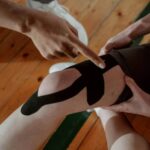Running is a popular form of exercise that offers numerous health benefits, including improved cardiovascular fitness and mental well-being. However, frequent or high-intensity running can lead to a variety of aches and injuries, with knee pain being one of the most common issues runners face. When the discomfort is located on the outside of the knee, it often raises specific concerns that need to be addressed properly to maintain a healthy running regimen.
Pain on the outside of the knee may be indicative of conditions such as iliotibial band syndrome (ITBS), lateral meniscus tears, or early signs of arthritis. ITBS, in particular, is characterized by a sharp, stabbing pain that is often felt during running as the iliotibial band, a ligament that runs down the outside of the thigh from the hip to the shin, becomes tight and inflamed. Accurate diagnosis and appropriate treatment are crucial for recovery and to prevent further damage.
Treatment strategies for running-related knee pain on the outside of the joint typically include rest, tailored exercises, and sometimes physical therapy. These interventions help reduce inflammation, improve joint function, and strengthen the muscles around the knee to support and stabilize the joint during physical activity. With proper care, most runners can return to their training, but understanding the underlying cause and taking preventive measures is key to mitigating the risk of re-injury.
Understanding Knee Pain in Runners
Knee pain in runners is often the result of several key factors, including mechanical issues and overuse, potentially affecting various structures within the knee joint.
Common Causes
- Anatomical and Biomechanical Factors: The alignment and movement patterns of a runner’s hips and knees are crucial. Issues such as misaligned gait or weak hip muscles can lead to improper knee tracking, resulting in pain.
- Overuse Injuries: Repetitive strain from running can lead to conditions such as runner’s knee (patellofemoral pain syndrome), a common ailment where the cartilage under the kneecap gets stressed.Overuse ConditionCharacteristicsRunner’s KneePain around or behind the kneecap; often worsens with activity and improves with rest.Iliotibial Band (ITB) SyndromePain on the outer side of the knee, often caused by tightness or inflammation of the IT band.
- Meniscus Issues: A meniscus tear, which can emerge from abrupt shifts during running, causes pain, swelling, and knee instability.
Types of Knee Pain
- Runner’s Knee: A dull ache around the anterior part of the knee is prominent. Patients report pain during activities like running, squatting, and climbing stairs.
- Iliotibial Band Syndrome: Runners exhibit sharp or burning pain on the outer side of the knee, which can be mistaken for a lateral meniscus issue but is related to the IT band.
- Patellofemoral Pain Syndrome: It typically refers to a throbbing pain in the front of the knee, originating from the area where the patella and the femur meet, exacerbated by sitting for long periods with bent knees.
Runners should attend to any knee discomfort promptly to prevent progression, as both acute injuries and chronic wear can lead to knee pain.
Diagnosis of Lateral Knee Pain
Diagnosing lateral knee pain effectively entails a blend of hands-on assessments by a doctor and the utilization of advanced imaging tests. The diagnosis process is pivotal for determining the underlying cause of knee pain and crafting a targeted treatment plan.
Physical Examination
Doctors conduct a thorough physical examination to check for signs of lateral knee pain. They start by collecting a detailed medical history, followed by an evaluation of the knee’s range of motion, alignment, and structure.
- Observation: Checking for visible swelling, redness, or deformities.
- Palpation: Identifying areas of tenderness along the outside of the knee.
- Range of Motion: Assessing if movements trigger or worsen the pain.
Doctors also perform specific tests, like the McMurray’s test, to evaluate meniscus integrity and the Ober’s test for IT band syndrome.
Imaging Tests
Imaging tests are critical in the diagnosis of lateral knee pain when a physical examination is inconclusive or indicates a potential underlying issue that requires a detailed view.
- X-ray: Utilized primarily to rule out bone fractures and degenerative joint diseases like arthritis.
- MRI (Magnetic Resonance Imaging): Offers detailed images of soft tissue, aiding in identifying meniscus tears, ligament injuries, and muscle strains.
- CT Scan (Computed Tomography): Less commonly used for soft tissue injuries but can provide a comprehensive view of the knee structure, combining multiple X-ray images.
Doctors recommend these imaging tests based on the patient’s symptoms and findings from the physical examination to ensure an accurate diagnosis.
Iliotibial Band Syndrome
Iliotibial Band Syndrome (ITBS) especially affects runners, leading to pain on the outside of the knee due to the iliotibial band’s movement.
Symptoms of IT Band Syndrome
Individuals with IT Band Syndrome typically experience a sharp or burning pain on the outside of the knee that can radiate up or down the leg. The discomfort is commonly felt when engaging in activity, particularly running, and might be accompanied by a clicking or popping sensation. Symptoms often intensify following foot strike and can vary from an ache to a feeling that inhibits regular motion.
- Local Pain: Persistent aching or burning on the lateral side of the knee.
- Radiating Discomfort: Pain may spread to the thigh or hip area.
- Audible Symptoms: Clicking or popping sounds may be present during movement.
- Pain Intensity: The severity can range from mild to severe enough to prevent continued activity.
Treatment and Exercises
Treatment for IT Band Syndrome is largely non-invasive, focusing on alleviating symptoms through rest, stretching, and strengthening exercises.
- Rest: Initially, reducing or ceasing activities that aggravate the IT band is critical.
- Ice Treatment: Apply ice to the affected area to reduce inflammation and pain.
- Stretching Exercises: Incorporate IT band-specific stretches to relieve tightness.
- Iliotibial Band Stretch: Cross one leg behind the other and lean to the opposite side until a stretch is felt along the outside of the thigh.
- Strengthening Exercises: Strengthen hip abductors and gluteal muscles to improve stability.
- Hip Thrusts: Strengthen the hips and buttocks while lying on your back with knees bent.
- Physical Therapy: Guidance from a healthcare professional can custom-tailor a rehabilitation program.
By adhering to these treatments and exercise directives, many individuals can return to their regular activities without lingering symptoms of IT Band Syndrome.
Management of Knee Pain
Effective management of knee pain depends on accurate diagnosis and appropriate treatment strategies. This ensures long-term relief and prevents further complications.
Initial Treatments
One should begin with RICE protocol: rest, ice, compression, and elevation to manage acute injuries and reduce pain and swelling. Rest allows the affected knee structures to heal, while ice can help reduce pain and inflammation. Compression with a bandage can further minimize swelling, and elevation of the leg can decrease the blood flow to the injured area to control swelling.
Physical therapy is often recommended to strengthen the surrounding muscles, improve flexibility, and stabilize the knee joint. A physical therapist can design an exercise program tailored to the individual’s condition.
Medications
For pain relief, over-the-counter non-steroidal anti-inflammatory medications (NSAIDs), like ibuprofen, are frequently used. These medications not only help alleviate pain but also address inflammation that contributes to discomfort.
In cases where oral medications do not provide sufficient relief, injections may be considered. Options include corticosteroids to reduce inflammation or platelet-rich plasma (PRP) injections, which use the patient’s own blood components to promote healing. However, one must remember to use medications as advised by healthcare professionals to mitigate potential side effects.
Prevention of Running-Related Knee Injuries
When it comes to preventing running-related knee injuries, focusing on proper training techniques and choosing the right gear are paramount. Attention to these areas can help runners maintain knee health and avoid common pitfalls such as misalignment and overuse injuries.
Proper Training Techniques
Training smart involves balancing running with strength training to enhance the stability of muscles that support the knee. An individual should incorporate exercises that target the core and glutes, as these muscle groups play critical roles in the alignment and stabilization of the lower body during running. Specific exercises that can aid in preventing knee injuries include:
- Squats and lunges for quadriceps and hamstrings
- Hip raises and bridges to strengthen glutes
- Planks and related exercises to fortify the core
It is also crucial to steadily increase running mileage over time, adhering to the principle of not increasing weekly mileage by more than 10%. Incorporate rest days to allow for muscle recovery and reduce risk of injury.
Choosing the Right Gear
Selecting suitable running shoes is fundamental for injury prevention. Runners should choose shoes that offer adequate arch support and cushioning to absorb the shock of running. The right running shoe will vary depending on an individual’s foot type and gait:
| Foot Type | Shoe Characteristic |
|---|---|
| Flat arches | Stability shoes with enhanced support |
| High arches | Cushioned shoes for better impact dispersion |
In some cases, custom orthotics may be recommended to address specific alignment issues. They can provide tailored arch support and correct improper foot movement, thus protecting the knees from misaligned stress.
Regular replacement of running shoes is also imperative, ideally every 300-500 miles, as worn-out shoes lose their ability to protect the knees effectively.
Rehabilitation and Physical Therapy
Effective rehabilitation for running-related knee pain often includes structured physical therapy programs and exercises that focus on strengthening and flexibility. These approaches aim to improve the condition of the knee by targeting the specific muscles and structures involved.
Structured Physical Therapy Programs
Physical therapy programs for runners typically follow a tailored plan designed to nurture the knee back to full health. The course of physical therapy may involve a variety of exercises and modalities to reduce pain and inflammation, and progressively rebuild knee function. The approach should be multidisciplinary, addressing the runner’s needs based on the type of injury and individual goals.
- Assessment: A thorough evaluation happens first to understand misalignments or muscular imbalances.
- Pain Management: Modalities such as ice, heat, or ultrasound may be used to manage symptoms.
- Controlled Exercises: Graduated strengthening and flexibility exercises are incorporated as pain allows.
Building Strength and Flexibility
The aim here is to strengthen weak muscles and improve flexibility to provide better support and reduce stress on the knee. Key muscles like the quads, quadriceps, and hips are often the focus in running knee rehabilitation.
Strength Training
- Quads: For quadriceps strengthening, straight leg raises and static holds can be effective. Begin with the leg straightened, then elevate it, hold briefly, and lower it back down.
- Hips: Exercises such as clamshells and hip bridges can help in promoting hip stability which is essential for runners.
Flexibility
- Stretching: Runners should incorporate stretches for the quads, hamstrings, and IT band, as tightness in these areas can contribute to knee pain. Ensure stretches are held for at least 30 seconds and performed consistently.
- Movement: Controlled squats and lunges can aid in increasing lower body flexibility as well as strength when performed correctly.
Throughout these exercises, maintaining proper form is critical in order to prevent further injury and to ensure that the knee is being adequately supported and strengthened.
Considerations for Athletes
Athletes engaging in running or sports with high-impact activities should be aware that knee pain can affect performance and should be managed carefully to avoid long-term issues.
Sports-Specific Concerns
Running: Repetitive motions and impact from running can lead to conditions such as runner’s knee or iliotibial band syndrome, especially if an athlete has weak quadriceps or tight hamstrings.
- Soccer: The sport entails rapid direction changes and twisting motions which can strain knee ligaments.
- Basketball: Athletes frequently experience knee pain due to jumping, pivoting, and sudden stops that place significant stress on the knee joints.
- Football: Often associated with knee sprains and instability due to its high-contact nature, football demands a focus on both strength training and flexibility to safeguard the knees.
- Cycling: Cyclists may experience knee pain from a repetitive motion that can cause stress if the bicycle setup is not ergonomically adjusted.
- Climbing: Involves complex leg movements that can put the knees at risk, especially during high-stepping or twisting maneuvers.
Long-Term Health and Performance
- Flexible Training: Incorporate a variety of exercises to ensure balanced muscle development and reduce overuse injuries to the knee.
- Preventive Measures: Adequately warming up, cooling down, and wearing proper footwear can mitigate risks.
- Medical Attention: Seek professional care for persistent knee pain, which may indicate a more serious condition. Timely intervention can prevent chronic issues.
Injury prevention strategies and effective treatment plans are crucial for an athlete’s long-term health and performance. Ensuring proper technique and addressing individual vulnerabilities can lead to a sustained athletic career.








